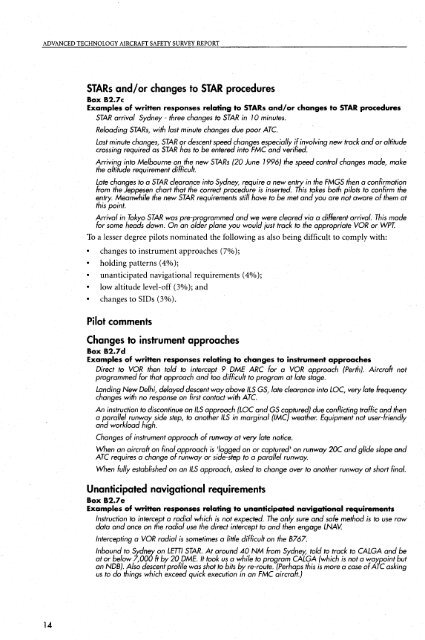Advanced Technology Aircraft Safety Survey Report - Australian ...
Advanced Technology Aircraft Safety Survey Report - Australian ...
Advanced Technology Aircraft Safety Survey Report - Australian ...
You also want an ePaper? Increase the reach of your titles
YUMPU automatically turns print PDFs into web optimized ePapers that Google loves.
ADVANCED TECHNOLOGY AIRCRAFT SAFETY SURVEY REPORT<br />
14<br />
STARs and/or changes to STAR procedures<br />
Box B2.7~<br />
Examples of wriiten responses relating to STARs and/or changes to STAR procedures<br />
STAR arrival Sydney - three changes to STAR in 70 minutes.<br />
Reloading STARs, with last minute changes due poor ATC.<br />
last minute chan es, STAR or descent speed changes especially if involving new track and or altitude<br />
crossing require 3 as STAR has to be entered into FMC and verified.<br />
Arriving into Melbourne on the new STARs [20 June 7 996) the speed control changes made, make<br />
the altitude requirement difficult.<br />
late chan es to a STAR clearance into Sydney, require a new ent in the FMGS then a confirmation<br />
from the 3 eppesen chart that the correct procedure is inserted. Txis takes both pilots to confirm the<br />
entry. Meanwhile the new STAR requirements still have to be met and you are not aware of them at<br />
this point.<br />
Arrival in Tokyo STAR was pre-programmed and we were cleared via a different arrival. This made<br />
for some heads down. On an older plane you would just track to the appropriate VOR or WPJ.<br />
To a lesser degree pilots nominated the following as also being difficult to comply with:<br />
changes to instrument approaches (7%);<br />
holding patterns (4%);<br />
unanticipated navigational requirements (4%);<br />
low altitude level-off (3%); and<br />
changes to SIDs (3%).<br />
Pilot comments<br />
Changes to instrument approaches<br />
Box B2.7d<br />
Examples of written responses relating to changes to instrument approaches<br />
Direct to VOR then told to intercept 9 DME ARC for a VOR approach [Perth). Aircrah not<br />
programmed for that approach and too difficult to program at late stage.<br />
landing New Delhi, delayed descent way above 11s GS, late clearance into lOC, very late frequency<br />
changes with no response on first contact with ATC.<br />
An instruction to discontinue an /IS a proach [LOC and GS ca tured) due conflicting traffic and then<br />
a parallel runway side step, to anot f: er 11s in marginal [IMCrweuther. Equipment not user-friendly<br />
and workload high.<br />
Changes of instrument approach of runway at very late notice.<br />
When an aircraft on final approach is 'logged on or captured' on runway 20C and glide slope and<br />
ATC requires a change of runway or side-step to a parallel runway.<br />
When fully established on an ILS approach, asked to change over to another runway at short final.<br />
Unanticipated navigational requirements<br />
Box B2.7e<br />
Examples of writkn responses relating to unanticipated navigational requirements<br />
Instruction to intercept a radial which is not expected. The only sure and safe method is to use raw<br />
data and once on the radial use the direct intercept to and then engage INAV<br />
Intercepting a VOR radial is sometimes a little difficult on the 8767.<br />
Inbound to Sydne on lEJJl STAR. At around 40 NM from Sydney, told to track to CAlGA and be<br />
at or below 7,OOJh by 20 DME. It took us a while to program CAlGA [which is not a way oint but<br />
an NDB). Also descent profile was shot to bits by re-route. [Perha s this is more a case of A P C asking<br />
us to do things which exceed quick execution in an FMC aircral)
















